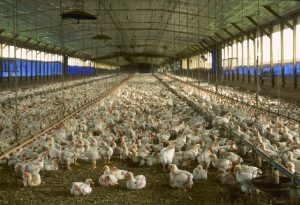
Photo Credit: Larry Rana/USDA
The Atlantic recently ran a very interesting article on the rise of the zombie small business that shows a bit of the reality of how agricultural and other businesses actually work in the modern era. It’s a far cry from what you learn in undergrad econ textbooks. Here are some excerpts:
But a government report released this spring calls into question whether all those family chicken farms are really family chicken farms, and whether those taxpayer dollars might be better spent elsewhere. The Small Business Administration’s inspector general looked at poultry growers, and found that many of them are tied-and-bound contractors—so controlled by their agreements with giant food corporations that they no longer act like independent entities. Why offer them taxpayer support meant for the little guy?
“The farm is not a real family farm, but a cog in this larger industrial-agriculture model,” said Joe Maxwell, a fourth-generation farmer and the executive director of the Organization for Competitive Markets. “This is a heavily concentrated marketplace with a vertically integrated model. That denies the consumer an independent market, and it extracts wealth from the independent farmer.”
…
But farmers have complained about and litigated against such contractual relationships for years. “The company has 99-and-a-half percent control over the grower,” said Jonathan Buttram, the president of the Alabama Contract Poultry Growers Association and an outspoken critic of the industry. “I’ll list what they tell you: what time to pick up the chickens, what time to run the feed, what time to turn the lights off and on, every move that you make. Then, they say we’re not an employee—we are employees, but they won’t let us have any kind of benefits or insurance.”Yet for all the control the poultry businesses have over the farmers, the farmers maintain significant financial and legal risk. They have little job security. They can get dumped for a different supplier, and face a tournament-style system that pits them against fellow growers. They are responsible for financing their own operations, and face the persistent threat of foreclosure.
Buttram said that he worried about the safety and health of the birds being produced for slaughter, many of which live lives of constant sickness and pain. “They pack these chickens in these houses so tight,” he said. “It’s nasty. It is hard to see.” He described farmers being instructed to dig pits to dispose of thousands of diseased chicken carcasses.
The system also takes an extraordinary toll on the contract growers themselves. The work is hard, the trade uncertain, the remuneration sometimes scant. Mental and physical health problems are common. “Back a few months ago, a grower called me and said he was going to kill his broiler manager and kill himself,” Buttram told me. “I never thought that I would have to be talking people out of committing suicide or committing murder. It shouldn’t be that an entity can coerce you into committing suicide when you have put everything on the line—your mortgage, your farm—and the company has nothing invested in it but a few chickens.”
…
The meat of the issue, experts said, is growing market concentration. If, as a farmer, you are not going to raise chickens for one of the big players, who are you going to raise them for? How are you going to get them to market? How would you ever get a loan? According to USDA data, about 20 percent of of growers report that there is only one integrator in their area, with another 30 percent reporting that there are only two.The industry is highly concentrated by many other measures. “Where there were once 1.6 million independent farms across the country, a rapid shift to a vertical-integration model has resulted in just 25,000 contract farms raising the vast majority of America’s poultry,” Representative Nydia Velázquez of New York noted at a hearing the House Small Business Committee held on the report in April. Most broiler chickens in the United States come from operations that process more than 500,000 birds a year.
It is not just a chicken-and-egg issue, either. The top four beef producers account for more than 80 percent of the market. The top four hog processors account for more than half. Much the same is true across the economy. The top four players account for more than 90 percent of overall revenue in a wide variety of market sectors and for a wide variety of consumer goods: web search, toilet paper, wireless services, arcade operations, soda, light bulbs, tires.
An estimated three-quarters of industries have seen a substantial increase in market concentration in the past two decades. There were about half as many publicly traded companies in 2014 as there were in 1997, a decline “so dramatic that the number of firms these days is lower than it was in the early 1970s, when the real gross domestic product in the U.S. was just one third of what it is today,” researchers have found. Those public companies are three times as big as they were in the 1990s.
Click over to read the whole thing.
from Aaron M. Renn
https://www.urbanophile.com/2018/09/06/a-glimpse-into-how-modern-agriculture-actually-works/
No comments:
Post a Comment